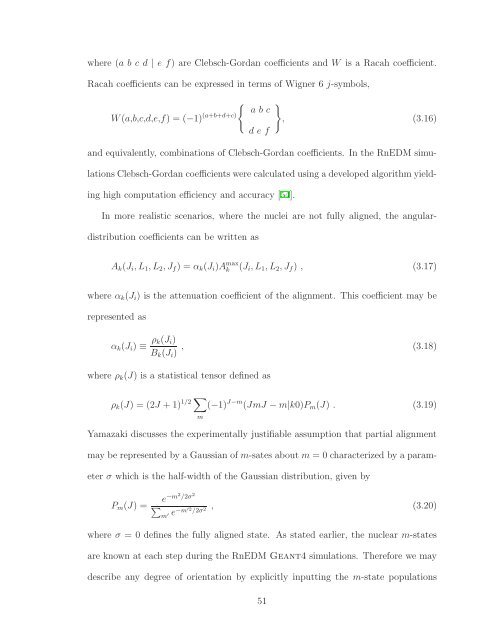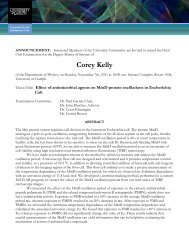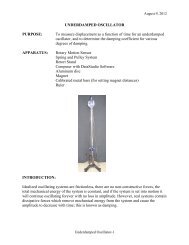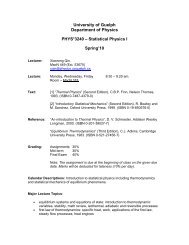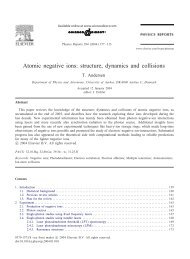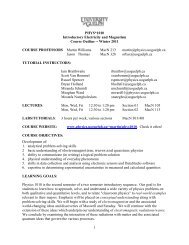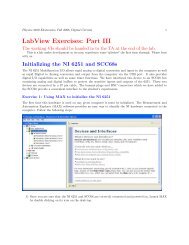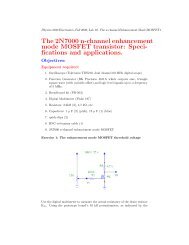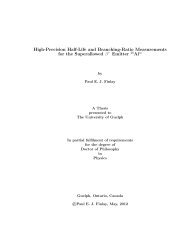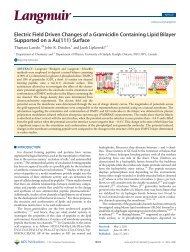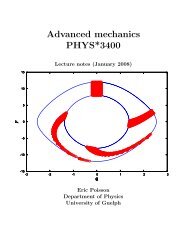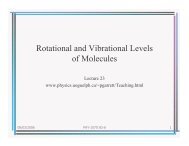Geant4 Simulations for the Radon Electric Dipole Moment Search at
Geant4 Simulations for the Radon Electric Dipole Moment Search at
Geant4 Simulations for the Radon Electric Dipole Moment Search at
Create successful ePaper yourself
Turn your PDF publications into a flip-book with our unique Google optimized e-Paper software.
where (a b c d | e f) are Clebsch-Gordan coefficients and W is a Racah coefficient.<br />
Racah coefficients can be expressed in terms of Wigner 6 j-symbols,<br />
W(a,b,c,d,e,f) = (−1) (a+b+d+c) {<br />
a b c<br />
d e f<br />
}<br />
, (3.16)<br />
and equivalently, combin<strong>at</strong>ions of Clebsch-Gordan coefficients. In <strong>the</strong> RnEDM simul<strong>at</strong>ionsClebsch-Gordan<br />
coefficients werecalcul<strong>at</strong>edusing adeveloped algorithmyielding<br />
high comput<strong>at</strong>ion efficiency and accuracy [54].<br />
In more realistic scenarios, where <strong>the</strong> nuclei are not fully aligned, <strong>the</strong> angulardistribution<br />
coefficients can be written as<br />
A k (J i ,L 1 ,L 2 ,J f ) = α k (J i )A max<br />
k (J i ,L 1 ,L 2 ,J f ) , (3.17)<br />
where α k (J i ) is <strong>the</strong> <strong>at</strong>tenu<strong>at</strong>ion coefficient of <strong>the</strong> alignment. This coefficient may be<br />
represented as<br />
α k (J i ) ≡ ρ k(J i )<br />
B k (J i ) , (3.18)<br />
where ρ k (J) is a st<strong>at</strong>istical tensor defined as<br />
ρ k (J) = (2J +1) 1/2∑ m<br />
(−1) J−m (JmJ −m|k0)P m (J) . (3.19)<br />
Yamazaki discusses <strong>the</strong> experimentally justifiable assumption th<strong>at</strong> partial alignment<br />
may be represented by a Gaussian of m-s<strong>at</strong>es about m = 0 characterized by a parameter<br />
σ which is <strong>the</strong> half-width of <strong>the</strong> Gaussian distribution, given by<br />
P m (J) =<br />
e −m2 /2σ 2<br />
∑m ′ e −m′2 /2σ 2 , (3.20)<br />
where σ = 0 defines <strong>the</strong> fully aligned st<strong>at</strong>e. As st<strong>at</strong>ed earlier, <strong>the</strong> nuclear m-st<strong>at</strong>es<br />
are known <strong>at</strong> each step during <strong>the</strong> RnEDM <strong>Geant4</strong> simul<strong>at</strong>ions. There<strong>for</strong>e we may<br />
describe any degree of orient<strong>at</strong>ion by explicitly inputting <strong>the</strong> m-st<strong>at</strong>e popul<strong>at</strong>ions<br />
51


